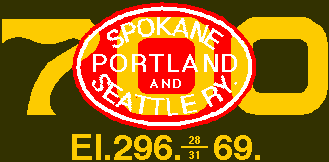Understanding the PRPA Logo

PRPA's logo consists of the SP&S oval intertwined with the lettering on the cab of the 700. Beneath the locomotive number, railroads often lettered basic information about the size and weight of the locomotive. This was useful for dispatchers who needed to know how much freight a locomotive could pull. It was also useful for engine crews, who were sometimes paid extra for operating larger locomotives.
The information beneath the 700 includes:
- E1 is the class of the locomotive. Although it looks like "Eee-Ell" for elevation, it is really "Eee-One." Railroads often used a letter-number combination for each class of locomotive. The 700s were the first (and only) 4-8-4s owned by the SP&S, so the number was "1". "E" was probably selected because it was one of the first letters of the alphabet not being used for any other locomotive class on the SP&S roster.
- 296 is the weight of the locomotive on its drivers: 296,500 pounds. This weight is particularly important for providing the locomotive with traction. The SP&S 700s shared with their NP sisters the distinction of having the most weight on their drivers of any Northern class locomotives built.
- 28/31 is the bore and stroke of the pistons in inches (which means each cylinder has about 19,000 cubic inches of displacement).
- 69 is the tractive effort of the locomotive: 69,800 pounds (the railroads tended to round down). Tractive effort was the railroads' standard measure of the strength of steam locomotives, and is a simple calculation representing the amount of force translated to the wheels by the steam and pistons:
Tractive effort = B^2 * S * BP * 85% / W where:
- B^2 is the square of the bore of the cylinders
- S is the stroke of the cylinders
- BP is the boiler pressure (260 pounds psi in the case of the 700)
- W is the diameter of the driving wheels in inches and
- 85 percent accounts for typical operations with the steam cut-off valve at 85 percent.
The cut-off valve effectively determines how much steam enters the cylinders on each stroke. When accelerating, steam locomotives typically were operated with no cut off, meaning cylinders would receive the full pressure of the boiler on each stroke. But this was wasteful because much of the power would be lost when the steam exhausted (which is what makes steam locomotives "chuff"). As the locomotive approached cruising speeds, the engineer would engage the cut-off valve, reducing the tractive effort but saving steam.
Today's Diesels are typically rated in terms of horsepower. Steam locomotives achieve their greatest horsepower at high speeds. The Northern Pacific rated sisters to the 700 at 4,500 horsepower at 50 miles per hour and at 5,600 horsepower at 60 miles per hour.
PRPA

